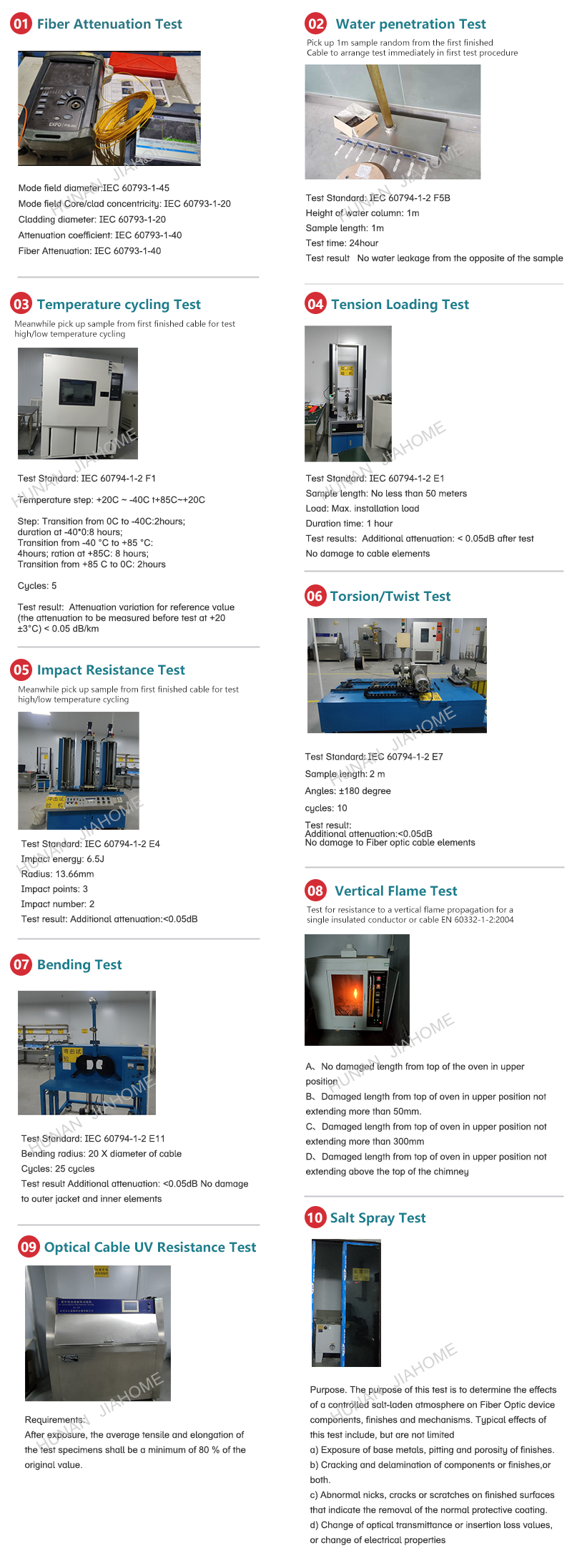Тестирование кабеля оптического заземляющего провода (OPGW) имеет решающее значение для обеспечения его целостности и работоспособности, особенно потому, что он сочетает в себе функции заземления и оптической связи. Ниже для справки приведено руководство по тестированию Хунань Цзяхоме:
1. Визуальный осмотр
Цель: Обнаружение любых физических повреждений, деформаций или признаков износа.
Метод:
- Осмотрите кабель на наличие видимых повреждений, таких как порезы, потертости или изгибы.
- Проверьте состояние разъемов и соединений.
- Ищите признаки коррозии или ущерба окружающей среде, особенно в местах соединения кабеля с опорами.
2. Тестирование оптического рефлектометра во временной области (OTDR).
Цель: Измерение характеристик оптоволокна и обнаружение повреждений, сращиваний и других событий вдоль кабеля.
Метод:
- Подключите рефлектометр к одному концу оптоволокна кабеля OPGW.
- Запустите тестовый импульс и проанализируйте отраженные сигналы.
- Определите местоположение и тип таких событий, как сращивания, изгибы или разрывы, на основе рефлектограммы.
- Сравните измеренные данные с базовыми данными, чтобы проверить наличие каких-либо отклонений.
3. Тестирование измерителя оптической мощности
Цель: измерить величину потерь оптической мощности в волокне.
Метод:
- Используйте измеритель оптической мощности и источник света.
- Подайте свет известного уровня мощности на один конец волокна.
- Измерьте выходную мощность на другом конце волокна с помощью измерителя оптической мощности.
- Рассчитайте вносимые потери, сравнив выходную мощность с входной мощностью.
4. Тестирование непрерывности
Цель: обеспечить отсутствие разрывов волокна и сохранение непрерывности кабеля.
Метод:
- Используйте визуальный дефектоскоп (VFL) или источник лазерного света, чтобы направить свет на один конец волокна.
- Визуально проверьте другой конец, чтобы убедиться, что свет проходит сквозь него, что указывает на непрерывность.
- Этот метод также полезен при выявлении разрывов или серьезных изгибов волокна.
5. Тестирование вносимых потерь
Цель: Измерить общие оптические потери в кабеле, включая все соединения и разъемы.
Метод:
- Используйте набор для тестирования оптических потерь (OLTS).
- Подключите источник света к одному концу волокна, а измеритель мощности — к другому.
- Измерьте общие потери и сравните их с допустимыми пределами, указанными для кабеля.
6. Тестирование поляризационной модовой дисперсии (PMD)
Цель: Измерить поляризационную модовую дисперсию, которая может повлиять на качество сигнала в высокоскоростных сетях.
Метод:
- Используйте анализатор PMD для подачи сигнала поляризованного света в волокно.
- Измерьте дифференциальную групповую задержку (DGD), чтобы определить PMD.
- Сравните значение PMD со спецификациями кабеля.
7. Заземление и электрические испытания.
Назначение: Обеспечить работоспособность заземления и электробезопасность кабеля.
Метод:
- Измерьте электрическое сопротивление кабеля OPGW с помощью цифрового мультиметра.
- Проверьте непрерывность пути заземления, чтобы обеспечить правильное заземление.
- Проверьте целостность заземляющих соединений в соединительных коробках и точках подключения.
8. Проверка торцевой поверхности волокна
Цель: Проверка качества торцов оптоволоконных разъемов.
Метод:
- Используйте оптоволоконный микроскоп или прицел для проверки волокна.
- Проверьте, нет ли на торцах волокна грязи, царапин или дефектов.
- При необходимости очистите и отполируйте разъемы.
9. Тестирование потерь в соединении
Цель: Измерить потери в точках соединения.
Метод:
- Используйте рефлектометр или OLTS для измерения потерь в сварном соединении.
- Убедитесь, что потери на стыке находятся в допустимых пределах.
10. Документация и отчетность
После тестирования документируйте все результаты, включая выявленные проблемы и их расположение.
Предоставьте подробный отчет с подробным описанием состояния кабеля OPGW и любыми рекомендациями по техническому обслуживанию или ремонту.
Лучшие практики:
Калибровка: убедитесь, что все испытательное оборудование откалибровано и работает правильно.
Безопасность: Соблюдайте протоколы безопасности, особенно при работе вблизи линий высокого напряжения.
Сравнение. Всегда сравнивайте результаты испытаний с базовыми данными или данными спецификаций, чтобы определить состояние кабеля.
Регулярные испытания и техническое обслуживание кабелей OPGW имеют решающее значение для обеспечения надежности и безопасности как систем передачи электроэнергии, так и систем связи, которые они поддерживают.
Время публикации: 09 августа 2024 г.


